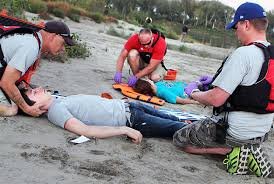Wilderness Water Safety Course
Conventional Lifeguard courses provide excellent training for environments such as pools, beaches, camp waterfronts, water parks, and water attractions within close proximity to Emergency Medical Services (EMS). Wilderness environments require special training to account for the different situations and endless variables that impact your trip in areas where EMS may take hours or days to respond. Wilderness Water Safety trains wilderness trip leaders to function as a lifeguard in a wilderness environment.
Prevention Focused.
Wilderness experiences involve risk. Managing risk is an essential part of the Wilderness Water Safety course. Risk management starts before the trip starts and certainly before trip participants enter the water. Getting into lakes, rivers and oceans is often an important part of the wilderness experience. Participants will understand how to effectively manage risks in remote aquatic environments.
Responding to Emergencies.
Even with strong risk management skills emergencies can happen. Wilderness Water Safety participants will learn to quickly assess an emergency, develop an emergency response and execute a rescue based on the conditions of the environment, person in trouble and the condition of the rescuer.
Scenario Based Learning.
Wilderness Water Safety is scenario focused based on actual emergencies that have occurred during wilderness tripping. The course is conducted in lakes and slow moving rivers along with classroom time. Participants will spend a large portion of the class actively engaged in prevention and rescue scenarios.
Course Requirements:
Participants will be required to demonstrate swimming competency in freestyle (front crawl) and/or breaststroke. In addition they must demonstrate a strong towing kick using a whip kick, scissors kick or egg beater kick.
Attend the entire 16-20 hour course
Participants will be required to perform a surface dive and swim to a depth of 8 feet or greater and recover an object in a lake environment.
2 Year Certification
Minimum 17 years of age
CPR and First Aid certifications are not part of Wilderness Water Safety. All participants must complete CPR and First Aid courses for the Wilderness Water Safety certification to be considered valid.
Lifeguarding
American Red Cross Lifeguard (with options Waterfront Module) includes CPR and First Aid
Although the Wilderness Water Safety course makes up 95% of the courses we teach, some organizations need Lifeguard certification as well. We have several American Red Cross Lifeguard Instructors available to teach Lifeguarding courses including the Waterfront module.
Course length: 20-28 hours including classroom, pool and online instruction
Course Requirements:
Students must be at least 15 years old by the last day of class.
Students must pass a pre-course swimming skills test prior to taking lifeguarding courses. This includes a 150-yard swim using front crawl or breaststroke, a 2-minute tread using legs only and the ability to retrieve a 10-lb dive weight from 7 ft deep, surface and swim 20 yds with the weight, using legs only and exit the pool without using a ladder within 100 seconds.
Customized Courses
Combination Wilderness Water Safety and American Red Cross Lifeguarding includes CPR and First Aid
Sometimes staff are leading wilderness trips and functioning as a lifeguard in more conventional settings. This course provides certification in both Red Cross Lifeguarding and Wilderness Water Safety.
Course requirements:
Minimum age 17
Participants will be required to demonstrate swimming competency in freestyle (front crawl) and/or breaststroke. In addition they must demonstrate a strong towing kick using a whip kick, scissors kick or egg beater kick.
Participants will be required to perform a surface dive and swim to a depth of 8 feet or greater and recover an object in a lake environment.
Students must pass a pre-course swimming skills test prior to taking lifeguarding courses. This includes a 300-yard swim using front crawl or breaststroke, a 2-minute tread using legs only and the ability to retrieve a 10-lb dive weight from 7 ft deep, surface and swim 20 yds with the weight, using legs only and exit the pool without using a ladder within 100 seconds.






